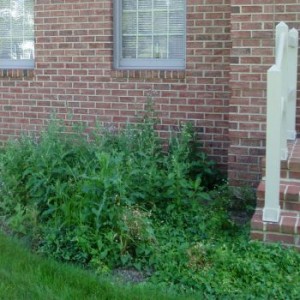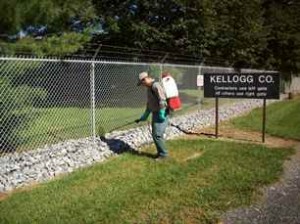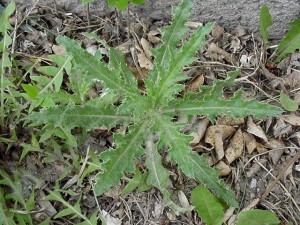What is this spiky weed?
The Canadian Thistle is a highly invasive weed in Pennsylvania. In fact, it has made the PA Noxious Weed List. This weed is problematic for many reasons. It is a prolific seeder. During summer months Canada thistle develops 1,000 to 1,500 seeds per flowering shoot! These seeds blow in from surrounding areas into your landscape beds, lawns, etc. These seeds can remain viable in soil up to 22 years! Keep reading to learn how to get rid of thistle in your landscape beds!
How do I get rid of thistle?
Most of the spread of Canadian Thistles isn’t even from seeding. This weed has an extensive root system that spreads underground shooting up new plants nearby. It doesn’t take long until a large part of a landscape bed is full of this nasty weed. Property owners often make the problem worse by pulling weeds.
 That’s right, pulling them can make the problem worse. It is easy to pop of most of the weed, but you won’t remove the entire plant. Most times there are segments of roots that are left in the soil. New thistles emerge in about 15 days after disturbance by tillage. Small root pieces of only just 0.25 inch long by 0.125 inch in diameter have enough stored energy to develop new plants! These small roots can survive at least 100 days without nutrient replenishment from photosynthesis. Canadian Thistle is one tough weed that wants to stay alive and re-grow!
That’s right, pulling them can make the problem worse. It is easy to pop of most of the weed, but you won’t remove the entire plant. Most times there are segments of roots that are left in the soil. New thistles emerge in about 15 days after disturbance by tillage. Small root pieces of only just 0.25 inch long by 0.125 inch in diameter have enough stored energy to develop new plants! These small roots can survive at least 100 days without nutrient replenishment from photosynthesis. Canadian Thistle is one tough weed that wants to stay alive and re-grow!
Treating to get rid of thistle
The best way to get rid of thistle is to use chemical control where possible. Chemical control with labeled herbicides will drastically help with thistle control. Pre-emergent weed controls applied 2-3 times per year will reduce weed seed germination. This can help with foreign seeds blowing into the beds as well as those laying dormant in the soil that have been there for years.
 In areas where there are no desirable plants nearby, non-selective weed controls such as glyphosate (Round-up) can be applied. Systemic herbicides do a great job as the materials are translocated throughout the root system, killing off all/most parts of the plants. It may also be advisable to add a small amount of an additional weed control for synergistic effects. Consult with a trained professional and the product label for recommendations. Be sure to mix these and any herbicides properly. More is not better. Follow the recommendations for how much concentrate should be added to the water in your mix.
In areas where there are no desirable plants nearby, non-selective weed controls such as glyphosate (Round-up) can be applied. Systemic herbicides do a great job as the materials are translocated throughout the root system, killing off all/most parts of the plants. It may also be advisable to add a small amount of an additional weed control for synergistic effects. Consult with a trained professional and the product label for recommendations. Be sure to mix these and any herbicides properly. More is not better. Follow the recommendations for how much concentrate should be added to the water in your mix.
Managing thistle growing between Landscape Plants
If you are trying to manage Canadian Thistles in landscape areas that have desirable plants, you will need to use a selective herbicide. There are some products that work great on thistles but won’t harm the majority of woody ornamental plants. This means it is possible to kill thistles in a bed of junipers or other groundcover if they are emerging, which is a task that hand-pulling would never accomplish effectively. Consult with a landscaping company that offers vegetation management services who will know what plants are able to handle these herbicides without any injury to desirable species.
No matter what your situation with thistles is, you will need to treat these areas many times throughout the growing season. Some areas will require 4-7 applications of herbicides throughout the year and even may warrant a few hand-pulling projects after weeds are wilted down and brown.
If you have problems with thistles in your landscape and would like to know the options for their control, please contact us.


